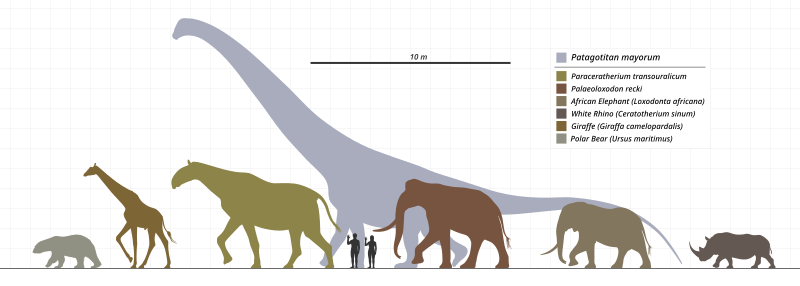File:Patagotitan vs Mammals Scale Diagram SVG Steveoc86.svg

Dimensioni di questa anteprima PNG per questo file SVG: 800 × 286 pixel. Altre risoluzioni: 320 × 114 pixel | 640 × 229 pixel | 1 024 × 366 pixel | 1 280 × 457 pixel | 2 560 × 915 pixel | 1 920 × 686 pixel.
File originale (file in formato SVG, dimensioni nominali 1 920 × 686 pixel, dimensione del file: 280 KB)
Cronologia del file
Fare clic su un gruppo data/ora per vedere il file come si presentava nel momento indicato.
| Data/Ora | Miniatura | Dimensioni | Utente | Commento | |
|---|---|---|---|---|---|
| attuale | 15:45, 14 lug 2024 | 1 920 × 686 (280 KB) | Steveoc 86 | Remove gap between foot and ground | |
| 22:30, 6 lug 2024 | 1 920 × 686 (372 KB) | Steveoc 86 | Increase giraffe size, other cosmetic adjustments | ||
| 01:36, 4 feb 2020 | 1 280 × 457 (277 KB) | Steveoc 86 | Update silhouette to new reconstruction. | ||
| 00:33, 23 set 2018 | 1 280 × 457 (277 KB) | Steveoc 86 | Update Patagotitan Silhouette. Reduce Elephant to normal size rather than an extremely rare world record. | ||
| 12:22, 20 apr 2018 | 1 280 × 457 (314 KB) | Steveoc 86 | Change from rasterized to normal text. | ||
| 23:27, 18 apr 2018 | 1 280 × 457 (420 KB) | Steveoc 86 | Swap in P.recki. Minor Edits. | ||
| 21:13, 1 nov 2017 | 1 280 × 457 (429 KB) | Steveoc 86 | Minor Edit to Elephant. | ||
| 23:43, 26 ott 2017 | 1 280 × 457 (429 KB) | Steveoc 86 | Minor adjustment of Giraffe. | ||
| 12:36, 23 ott 2017 | 1 280 × 457 (423 KB) | Steveoc 86 | Add in Palaeoloxodon and Paraceratherium | ||
| 15:04, 17 ott 2017 | 1 280 × 457 (344 KB) | Steveoc 86 | Update silhouettes. Shrink giraffe to be 5.88 at maximum verticle reach. |
Pagine che usano questo file
La seguente pagina usa questo file:
Utilizzo globale del file
Anche i seguenti wiki usano questo file:
- Usato nelle seguenti pagine di ar.wiki.x.io:
- Usato nelle seguenti pagine di cs.wiki.x.io:
- Usato nelle seguenti pagine di en.wiki.x.io:
- Usato nelle seguenti pagine di es.wiki.x.io:
- Usato nelle seguenti pagine di fr.wiki.x.io:
- Usato nelle seguenti pagine di nl.wiki.x.io:
- Usato nelle seguenti pagine di pt.wiki.x.io:
- Usato nelle seguenti pagine di ru.wiki.x.io:
- Usato nelle seguenti pagine di sq.wiki.x.io:
- Usato nelle seguenti pagine di tr.wiki.x.io:
